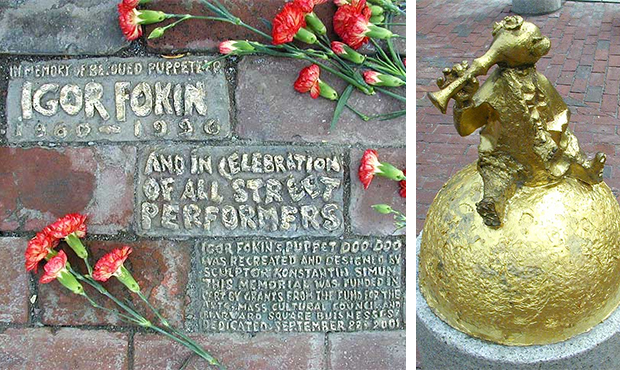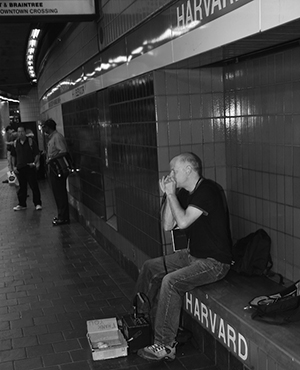Street Performance

The little statue in Brattle Square is dedicated to Igor Fokin, a street puppeteer from Russia. He graduated from the St. Petersburg Theatrical Institute of Russia and moved to Cambridge in the summer of 1993, with nothing but a box of hand-carved wooden puppets. He sewed their costumes and painted their fingernails. Upon arriving in Cambridge, he set up a 15 minute show in Harvard Square, which people loved to watch. In 1994 he brought over his wife and son from Russia and was able to stay in the US on a visa for “a person of extraordinary ability and talent.” He performed at the 1996 Olympic festivities in Atlanta. Unfortunately, Fokin died of a heart attack in 1996 at the age of 36. While he is no longer with us, this statue was installed in 2001 to honor his legacy.
Igor Fokin is of course not the only person to put on street performances in Harvard Square. Harvard Square has a rich history of street performances, beginning in the 1960’s. Before 1966 street performances were sporadic; there were some players like Joan Baez, but it was not a regular occurrence. The scene really took off in the 1970’s. There were tons of performers, but they faced a lot of adversity from the city. Many were arrested, so between 1975 and 1977, letters were sent to the mayor to stop their arrests. They were somewhat successful, because the First Cambridge Street Performance Ordinance was passed in 1976. The ordinance limited hours from 1pm to 10pm and confined performers to three spots: the traffic triangle in Brattle Square (ie here), Cambridge Common, and Winthrop Park. No amplification was allowed and a $2 permit fee was charged. Most performers performed here at the traffic triangle and over at Holyoke center under a private permit system issued by Harvard Real Estate. Despite this great advance, there were still many arrests and threats of arrest. But it was during this time period that the scene really grew into one of the most respected and talented performance spaces in the world, featuring artists like the Fantasy Jugglers, the Shakespeare Brothers (who were mimes and actors), and Brother Blue (a rapper/storyteller). This legacy of performers also allowed Amanda Palmer to get her start. Amanda Palmer is known today as both a solo musician and a member of the Dresden Dolls, a dark cabaret band. She got her start however, as the 8-foot bride, a living statue at Holyoke Center.
In 1990 the Second Cambridge Street Performers Ordinance was passed, after a protracted legal battle that involved a Federal Lawsuit. The new ordinance allowed for amplification at 80db to 50ft and selling of recordings. The hours were extended as well from 7am to 11pm and performances were now open to the entire city. The ordinance was changed again in 1995, which changed the hours once more, and also raised the permit fee to $40, which pays street performance monitors. Monitors are part-time seasonal workers who act as advocates for performers. Monitors work for the Cambridge Arts Council who also oversees permits. They sell between 275 and 400 per year, which are given to a combination of both new and established artists.
Street performances were also encouraged by the expansion of the Red Line on the MBTA in the 1980’s. When the line was expanded out to Alewife, they rehabilitated many of the older stations, including the one in Harvard Square. They completely reconstructed the station and built in areas around the square specifically for performance. The pit behind the station was meant to be a premiere spot for buskers and they also redesigned much of the square to be conducive to buskers and their audiences.
 |
 |